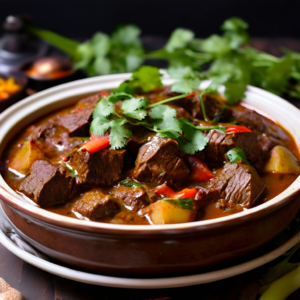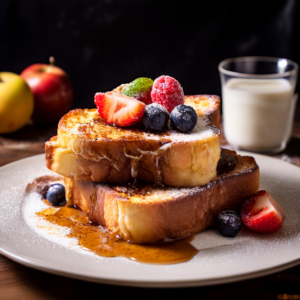Beef Sri Lankan Curry – Tradition and Taste Combined
Sri Lankan Beef Curry – Tradition and Taste Combined
“Savor the rich and spicy flavors of Beef Sri Lankan Curry. Discover authentic recipes, cooking tips, and the cultural significance of this beloved dish. Perfect for food enthusiasts looking to spice up their culinary repertoire.”
Introduction
What’s better than a warm, hearty meal that packs a punch of flavor? Beef Sri Lankan Curry is just that. It’s a dish that combines tender beef with a medley of spices to create a mouth-watering experience. But what makes this curry so special, and why is it beloved by many? Let’s dive in!
History of Sri Lankan Cuisine
Origins of Sri Lankan Curry
Sri Lankan cuisine is a vibrant mix of flavors, influenced by centuries of trade and colonization. The island’s location made it a hub for spice trade, which is why spices are a cornerstone of its cuisine. Beef curry, in particular, showcases the rich history and cultural fusion.
Influence of Various Cultures
Portuguese, Dutch, and British colonizers, along with Indian, Arab, and Malay traders, have all left their mark on Sri Lankan food. This blend of influences results in a unique culinary tradition that balances sweet, savory, and spicy elements.
Ingredients for Beef Sri Lankan Curry
Ingredients Needed
- 500g beef, cut into chunks
- 2 tablespoons roasted curry powder
- 1 onion, finely chopped
- 2 cloves garlic, minced
- 1-inch piece of ginger, minced
- 1 cinnamon stick
- 4 cardamom pods
- 4 cloves
- 1 sprig curry leaves
- 1 can coconut milk
- 2 tablespoons vegetable oil
- Salt to taste
- Water as needed
Essential Spices
To make an authentic Beef Sri Lankan Curry, you need a variety of spices. The essentials include turmeric, cumin, coriander, fennel seeds, and black pepper. Each spice plays a crucial role in creating the depth of flavor characteristic of this dish.
Key Ingredients
Aside from spices, you’ll need beef, coconut milk, onions, garlic, ginger, tomatoes, and curry leaves. Fresh ingredients make a significant difference, so try to use the freshest available.
Preparation Steps
Marinating the Beef
Start by marinating the beef. Mix it with turmeric, salt, and a bit of lime juice. Let it sit for at least 30 minutes. This step tenderizes the meat and infuses it with initial flavors.
Preparing the Spice Mix
Next, prepare the spice mix. Toast the cumin, coriander, fennel seeds, and black pepper in a dry pan until fragrant. Grind them into a fine powder. This fresh spice mix will elevate your curry to new heights.
Cooking the Beef Sri Lankan Curry
Sautéing the Spices
Heat some oil in a pot and add the onions, garlic, ginger, and curry leaves. Sauté until the onions are golden brown. This process is essential for building the flavor base of your curry.
Cooking the beef Sri Lankan curry
Add the marinated beef to the pot and cook until browned. Then, add the spice mix and tomatoes. Cook for a few minutes before pouring in the coconut milk. Let the curry simmer on low heat until the beef is tender and the flavors have melded together.
Serving Suggestions
Traditional Accompaniments
Serve your Beef Sri Lankan Curry with steamed rice, roti, or string hoppers. These traditional sides help soak up the rich curry sauce.
Modern Twists
For a modern twist, try serving the curry with quinoa or cauliflower rice. These lighter options balance the richness of the curry.
Health Benefits
Nutritional Value
Beef Sri Lankan Curry is not just delicious but also nutritious. Beef is a great source of protein and iron, while the spices offer various health benefits.
Benefits of Spices
Turmeric is known for its anti-inflammatory properties, cumin aids digestion, and coriander is rich in antioxidants. The combination of these spices makes the curry not only flavorful but also beneficial for your health.
Popular Variations
Regional Variations
Different regions in Sri Lanka have their own versions of beef curry. Some might use more coconut milk, while others might prefer a spicier version. Exploring these variations can be a culinary adventure.
Vegetarian Alternatives
If you prefer a vegetarian option, you can substitute the beef with potatoes, chickpeas, or tofu. The rich spice mix works wonderfully with these ingredients as well.
Tips for the Perfect Curry
Cooking Tips
- Always toast your spices for maximum flavor.
- Use fresh ingredients whenever possible.
- Simmer the curry slowly to allow the flavors to develop fully.
Common Mistakes to Avoid
- Don’t rush the cooking process. Good curry takes time.
- Avoid using pre-ground spices if you can. Freshly ground spices make a big difference.
- Be mindful of the balance of spices. Too much of one can overpower the others.
Pairing with Other Dishes
Side Dishes
A fresh salad, cucumber raita, or mango chutney can complement the spicy beef curry beautifully. These sides add a refreshing contrast to the rich curry.
Beverages
Pair your curry with a cold beer, a glass of dry white wine, or a refreshing lassi. These drinks can help balance the heat and enhance your dining experience.
Storing and Reheating
Best Practices for Storing
Store leftover curry in an airtight container in the refrigerator. It can last for up to 3 days.
How to Reheat without Losing Flavor
Reheat the curry gently on the stove over low heat. Add a splash of water or coconut milk if it looks too thick. Avoid microwaving as it can make the beef tough.
Beef Sri Lankan Curry: Advantages and Disadvantages
Introduction
Sri Lankan cuisine is a vibrant tapestry of flavors and aromas, weaving together influences from various cultures and traditions. One dish that stands out in this rich culinary landscape is Beef Sri Lankan Curry. Known for its robust flavor profile and aromatic spices, this curry has garnered fans worldwide. But what exactly makes this dish so special? Let’s delve into the world of Beef Sri Lankan Curry, exploring its advantages and disadvantages.
What is Beef Sri Lankan Curry?
Beef Sri Lankan Curry is a traditional dish made using a unique blend of spices, coconut milk, and tender beef chunks. The curry’s rich, dark color comes from roasted curry powder, a staple in Sri Lankan kitchens. Ingredients like cinnamon, cardamom, cloves, and curry leaves contribute to its complex flavor.
Advantages of Beef Sri Lankan Curry
Rich Flavor Profile
One of the main attractions of Beef Sri Lankan Curry is its intense, multi-layered flavor. The combination of spices creates a symphony of taste that is both bold and nuanced. Each bite offers a new sensation, making it a culinary adventure.
Nutritional Benefits
Beef is a great source of high-quality protein, which is essential for muscle repair and growth. Additionally, the spices used in the curry, such as turmeric and garlic, have anti-inflammatory and antioxidant properties. The coconut milk adds a healthy dose of good fats and essential vitamins and minerals.
Cultural Experience
Eating Beef Sri Lankan Curry is not just about satisfying your hunger; it’s about experiencing a piece of Sri Lankan culture. This dish is a staple in many households and is often prepared during festivals and special occasions.
Versatility
This curry is incredibly versatile. You can serve it with rice, roti, or even bread. It can be part of a grand feast or a simple weeknight dinner. You can adjust the spice levels and ingredients to suit your taste preferences.
Homemade Benefits
Making Beef Sri Lankan Curry at home allows you to control the quality and quantity of the ingredients. You can ensure that your curry is free from preservatives and artificial additives, making it a healthier option compared to restaurant versions.
Disadvantages of Beef Sri Lankan Curry
High Caloric Content
One of the downsides of Beef Sri Lankan Curry is its high caloric content. The combination of beef, coconut milk, and oil used for frying the spices can lead to a calorie-dense dish. Consuming it frequently may contribute to weight gain.
Spiciness
Sri Lankan cuisine is known for its bold use of spices, and this curry is no exception. The heat level might be too much for some people, especially those who are not accustomed to spicy food.
Preparation Time
Preparing Beef Sri Lankan Curry is a labor of love. It involves marinating the beef, roasting and grinding spices, and slow-cooking the curry to perfection. This lengthy process might be a deterrent for those with busy schedules.
Ingredient Availability
Finding authentic Sri Lankan spices can be a challenge, especially if you live outside of Sri Lanka or in a region without a large Asian grocery store. Substituting these spices can alter the flavor profile of the curry.
Dietary Restrictions
Beef Sri Lankan Curry is not suitable for everyone. Those following a vegetarian, vegan, or certain religious diets will need to look for alternatives. Additionally, the high fat content from the coconut milk might not be suitable for individuals with certain health conditions.
Frequently Asked Questions
FAQ 1: Can I use different meats?
Absolutely! You can substitute beef with chicken, lamb, or even fish. Each meat will bring its unique flavor to the curry.
FAQ 2: How spicy is it?
The spice level can be adjusted to your preference. If you like it milder, reduce the amount of chili. For a spicier kick, add more.
FAQ 3: Can I make it ahead of time?
Yes, in fact, the flavors often develop and improve after a day. Make it a day ahead for an even tastier curry.
FAQ 4: What if I don’t have all the spices?
You can use a ready-made curry powder as a substitute, but try to get a high-quality one for the best results.
FAQ 5: Is it suitable for freezing?
Yes, you can freeze Beef Sri Lankan Curry. Portion it into airtight containers and freeze for up to 3 months. Thaw in the refrigerator before reheating.
Conclusion
Beef Sri Lankan Curry is a delicious and flavorful dish that brings the rich culinary traditions of Sri Lanka to your kitchen. With its perfect balance of spices and tender beef, it’s sure to become a favorite. Try making it yourself and enjoy the vibrant flavors that this dish has to offer.




